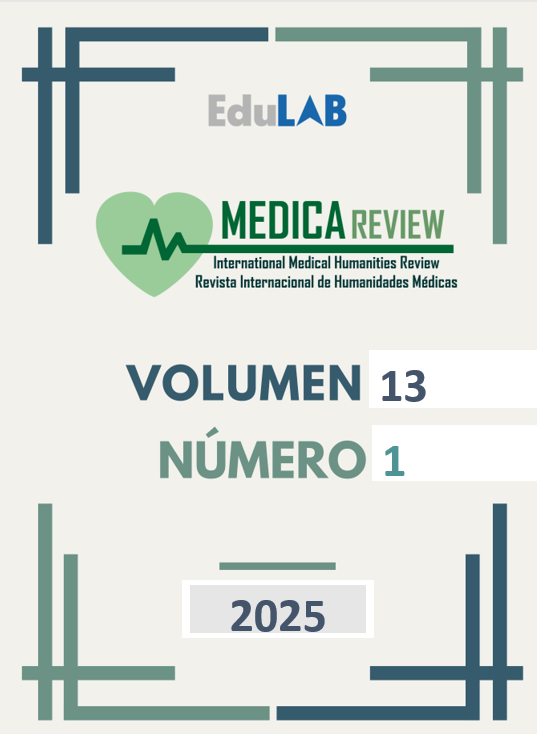¿QUIÉN SE HA LLEVADO MI PLACENTA? NARRACIONES PLACENTARIAS: Episteme y política desde una bioética feminista y decolonial
DOI:
https://doi.org/10.62701/revmedica.v13.5459Palabras clave:
Placenta, Bioética, Feminismo, Giro decolonialResumen
Este artículo presenta un abordaje multidisciplinar sobre la placenta para entender su tratamiento en diferentes culturas y contextos históricos. Se parte de la bioética feminista y decolonial, para realzar la importancia de las narraciones maternas como fuente de conocimiento autorizado. Como principal objetivo, se realiza una revisión narrativa crítica sobre una historia etnocultural de la placenta; de ahí, se acuñan y desarrollan conceptos como narrativas/relatos placentarios, revival placentario o agencia placentaria, para enriquecer críticamente, en lo epistémico y político, el discurso al respecto de la placenta, recomendándose finalmente la regulación jurídica de los derechos directos de las madres sobre sus propias placentas.
Estadísticas globales ℹ️
|
450
Visualizaciones
|
120
Descargas
|
|
570
Total
|
|
Citas
ABC News. (2021, May 14). Why more women are embracing placenta rituals. ABC News. https://www.abc.net.au/news/2021-05-14/why-more-women-are-embracing- placenta-rituals/100064656
Arancibia Flores, N. (2019). Derecho al uso de la placenta como ritual cultural o medicina tradicional, fuera de las comunidades indígenas bolivianas. Revista Lex, 3(7), 52–66. https://doi.org/10.33996/revistalex.v3i7.45
Bastien, A. (2017). Circling the red tent. In N. Jordan (Ed.), Placenta wit: Mother stories, rituals, and research (pp. 103–114). Demeter Press. https://www.jstor.org/stable/j.ctt1rrd8sv.14
Battaglia, J. E. (2017). Placenta wit and chick lit: A close textual analysis of The Lost Journals of Sylvia Plath by Kimberly Knutsen. In N. Jordan (Ed.), Placenta wit: Mother stories, rituals, and research (pp. 204–219). Demeter Press. https://www.jstor.org/stable/j.ctt1rrd8sv.22
Bellsola, Y., Gómez Jaramillo, D., & Grinman, V. (2017). La placenta: Conservación, usos, propiedades y rituales. Doula Natal.
Ben-Senior, L. (2021, January). Honoring the placenta in different cultures. Parents Guide to Cord Blood. https://parentsguidecordblood.org/en/news/honoring-placenta- different-cultures
Borek, V. (2017). A placenta by any other name. In N. Jordan (Ed.), Placenta wit: Mother stories, rituals, and research (pp. 179–189). Demeter Press. https://www.jstor.org/stable/j.ctt1rrd8sv.20
Burns, E. (2014). More than clinical waste? Placenta rituals among Australian home-birthing women. The Journal of Perinatal Education, 23(1), 41–49. https://doi.org/10.1891/1058-1243.23.1.41
Burns, E. (2017). Discourses of love and loss: The placenta at home. In N. Jordan (Ed.), Placenta wit: Mother stories, rituals, and research (pp. 74–84). Demeter Press. https://www.jstor.org/stable/j.ctt1rrd8sv.10
Bustos, B. F. (2021). La regulación de la placenta en Chile: Reflexiones antropológicas en torno a las políticas públicas y la legislación sanitaria. Maguaré, 35(2), 127–160.
Carmona García, S. (2024). Neuromaternal: ¿Qué le pasa a mi cerebro durante el embarazo y la maternidad? Ediciones B.
Carrasco Sotos, A. (2020). Guía secreta de Las Pedroñeras. Ediciones Olcades.
Cavarero, A. (1997). Tu che mi guardi, tu che mi racconti: Filosofia della narrazione.
Feltrinelli.
Chawla, J. (2017). “Baby’s life is in the placenta only”: Hearing Dais’ voices in India. In N. Jordan (Ed.), Placenta wit: Mother stories, rituals, and research (pp. 190–203). Demeter Press. https://www.jstor.org/stable/j.ctt1rrd8sv.21
Chen, H. (2024). Between living and non-living: Materiality of the placenta in Ming China. Berichte zur Wissenschaftsgeschichte, 47(4), 382–395. https://doi.org/10.1002/bewi.202400002
Cohen Shabot, S. (2020). We birth with others: Towards a Beauvoirian understanding of obstetric violence. European Journal of Women’s Studies, 28(2), 213–228. https://doi.org/10.1177/1350506820919474
Comité de Bioética de Catalunya. (2021). Humanizar y dignificar la atención durante el embarazo y el nacimiento: Una mirada desde la bioética. Generalitat de Catalunya, Departamento de Salud.
https://canalsalut.gencat.cat/web/.content/_Sistema_de_salut/CBC/recursos/doc uments_tematica/humanitzar-dignicar-embaras-naixement-es.pdf
Contreras Molina, R., & Berho Castillo, M. (2022). Placenta: Móviles, usos y significaciones en el centro-sur de Chile. Salud Colectiva, 18, e4102. https://doi.org/10.18294/sc.2022.4102
Cooper, B. M. (2019). Traveling companions: The burial of the placenta in Niger. African Studies Review, 62(2), 127–148. https://doi.org/10.1017/asr.2018.17
Cordoni, C. (2017). Snakes, berries, and bears: A father’s placenta story. In N. Jordan (Ed.), Placenta wit: Mother stories, rituals, and research (pp. 220–226). Demeter Press. https://www.jstor.org/stable/j.ctt1rrd8sv.23
Costanzo, V., Bardelli, A., Siena, S., & Abrignani, S. (2018). Exploring the links between cancer and placenta development. Open Biology, 8(6), 180081.
https://doi.org/10.1098/rsob.180081
Davidson, J. R. (1983). La sombra de la vida: La placenta en el mundo andino. Bulletin de l’Institut Français d’Études Andines, 12(3-4), 69–81. https://doi.org/10.3406/bifea.1983.1574
Davidson, J. R. (1985). The shadow of life: Psychosocial explanations for placenta rituals. Culture, Medicine and Psychiatry, 9(1), 75–92. https://doi.org/10.1007/BF00048538
Davis-Floyd, R. E. (2004). Birth as an American rite of passage. University of California Press. Dhar, N., Chaturvedi, S. K., & Nandan, D. (2013). Spiritual health, the fourth dimension: A public health perspective. WHO South-East Asia Journal of Public Health, 2(1), 3–5.
World Health Organization. Regional Office for South-East Asia. https://iris.who.int/handle/10665/329763
Domingo Moratalla, T., & Feito Grande, L. (2020). Bioética narrativa aplicada. Guillermo Escolar.
Donaghy, P. (2023). The secrets of the placenta in European anatomy and midwifery, 1560– 1700. Isis, 114(2), 249–271. https://doi.org/10.1086/724867
Einion, A. (2017). “I’m just going to give you the injection for the placenta”: Active management of the third stage and the myth of informed consent. In N. Jordan (Ed.), Placenta wit: Mother stories, rituals, and research (pp. 45–56). Demeter Press. https://www.jstor.org/stable/j.ctt1rrd8sv.8
Garnaoui, A. (2017). The amazing placenta: The placenta’s behavioural and structural peculiarities. In N. Jordan (Ed.), Placenta wit: Mother stories, rituals, and research (pp. 130–141). Demeter Press. https://www.jstor.org/stable/j.ctt1rrd8sv.16
Garnier, M.-D. (2017). Hélène Cixous: Matrix writrix. In N. Jordan (Ed.), Placenta wit: Mother stories, rituals, and research (pp. 115–129). Demeter Press. https://www.jstor.org/stable/j.ctt1rrd8sv.15
Garrafa, V., & Manchola, C. (2014). La bioética: Una herramienta para la construcción de la paz. Revista Colombiana de Bioética, 9(2), 95–106. https://doi.org/10.18270/rcb.v9i2.714
Grau, O. (2018). La materia de un nuevo deseo: La placenta placentera. Nomadías, 24, 131–
Recuperado de https://nomadias.uchile.cl/index.php/NO/article/view/49967 Greavette, A., & Jordan, N. (2017). Artful pause II. In N. Jordan (Ed.), Placenta wit: Mother stories, rituals, and research (pp. 157–164). Demeter Press.
https://www.jstor.org/stable/j.ctt1rrd8sv.18 Han, B.-C. (2020). La desaparición de los rituales. Herder.
Helsel, D. G., & Mochel, M. (2002). Afterbirths in the afterlife: Cultural meaning of placental disposal in a Hmong American community. Journal of Transcultural Nursing, 13(4), 282–286. https://doi.org/10.1177/104365902236702
Jordan, N. (2017a). Front matter. In Placenta wit: Mother stories, rituals, and research (pp. i– vi). Demeter Press. https://www.jstor.org/stable/j.ctt1rrd8sv.1
Jordan, N. (2017b). Introduction. In Placenta wit: Mother stories, rituals, and research (pp.
–18). Demeter Press. https://www.jstor.org/stable/j.ctt1rrd8sv.4
Jordan, N. (2017c). Placental thinking: The gift of maternal roots. In Placenta wit: Mother stories, rituals, and research (pp. 142–156). Demeter Press. https://www.jstor.org/stable/j.ctt1rrd8sv.17
Lavialle, C., Cornelis, G., Dupressoir, A., Esnault, C., Heidmann, O., Vernochet, C., & Heidmann,
T. (2013). Paleovirology of ‘syncytins’, retroviral env genes exapted for a role in placentation. Philosophical Transactions of the Royal Society B: Biological Sciences, 368(1626), 20120507. https://doi.org/10.1098/rstb.2012.0507
Link-Troen, N. (2017). Slightly inappropriate, but really brilliant. In N. Jordan (Ed.), Placenta wit: Mother stories, rituals, and research (pp. 38–44). Demeter Press. https://www.jstor.org/stable/j.ctt1rrd8sv.7
Maiarú, J. (2024). El quiasmo narración-afecto. Revista Estudos Feministas, 32(3). https://doi.org/10.1590/1806-9584-2024v32n399477
Maltepe, E., & Fisher, S. J. (2015). Placenta: The forgotten organ. Annual Review of Cell and Developmental Biology, 31, 523–552. https://doi.org/10.1146/annurev-cellbio-
-125620
Mann, B. A. (2017). “Placental waste”: Wild boys, blood-clot boys, and long-teeth boys. In N. Jordan (Ed.), Placenta wit: Mother stories, rituals, and research (pp. 57–73). Demeter Press. https://www.jstor.org/stable/j.ctt1rrd8sv.9
Martín Herrera, D. (2017). La placenta, un vínculo de conexión entre el neonato y la Pachamama gestionado como residuo. Análisis crítico de una sentencia concerniente a la bioética. Bioderecho.es, 4, 31. Recuperado de https://revistas.um.es/bioderecho/article/view/291201
Martínez Dueñas, W. A. (2023). ¿Es posible una bioética intercultural decolonial?. Jangwa Pana, 21(3), 174–175. https://doi.org/10.21676/16574923.5119
Massó Guijarro, E. (2013). Lactancia materna y revolución, o la teta como insumisión biocultural: Calostro, cuerpo y cuidado. Dilemata, 11, 169–206. Recuperado de https://www.dilemata.net/revista/index.php/dilemata/article/view/198
Massó Guijarro, E. (2023). Violencia obstétrica como injusticia epistémica: El parto en disputa. Salud Colectiva, 19. https://doi.org/10.18294/sc.2023.4464
Massó Guijarro, E. (2024). Lactancia materna y violencia obstétrica: En el camino de una soberanía lactante. MEDICA REVIEW. International Medical Humanities Review, 12(1), 10–23. https://doi.org/10.62701/revmedica.v12.5417
Massó Guijarro, E., & Mantilla, J. (2025). Los relatos de parto como capital social: Narrativas contemporáneas sobre la transformación de la identidad personal a partir de la maternidad [En vías de publicación].
Maxwell, A., Adzibolosu, N., Hu, A., You, Y., Stemmer, P. M., Ruden, D. M., Petriello, M. C., Sadagurski, M., Debarba, L. K., Koshko, L., Ramadoss, J., Nguyen, A. T., Richards, D., Liao, A., Mor, G., & Ding, J. (2023). Intrinsic sexual dimorphism in the placenta determines the differential response to benzene exposure. iScience, 26(4), 106287. https://doi.org/10.1016/j.isci.2023.106287
McMullen, N., Fiolet, R., Redley, B., & Hutchinson, A. M. (2024). A beautiful bush space on Country: Indigenous women’s perspectives on the cultural significance of a placenta garden. Women and Birth, 37(1), 101630.
https://doi.org/10.1016/j.wombi.2024.101630
Mena-Tudela, D., Iglesias-Casás, S., González-Chordá, V. M., Cervera-Gasch, Á., Andreu-Pejó, L., & Valero-Chilleron, M. J. (2020). Obstetric violence in Spain (Part I): Women’s perception and interterritorial differences. International Journal of Environmental
Research and Public Health, 17(21), 7726.
https://doi.org/10.3390/ijerph17217726
Merleau-Ponty, M. (2010). Lo visible y lo invisible. Notas de trabajo. Nueva Visión.
Moeller, C., & Selander, J. (2017). Artful pause I. In N. Jordan (Ed.), Placenta wit: Mother stories, rituals, and research (pp. 85–92). Demeter Press. https://www.jstor.org/stable/j.ctt1rrd8sv.11
Moeti, C., Rasweswe, M. M., & Motswagole, B. S. (2023). The disposal of placenta among indigenous groups globally: An integrative literature review. International Journal of Reproductive Medicine, 2023, 6676809. https://doi.org/10.1155/2023/6676809
Morgan-Ortiz, F., Morgan-Ruiz, F. V., Quevedo-Castro, E., Gutiérrez-Jiménez, G., & Báez- Barraza, J. (2015). Anatomía y fisiología de la placenta y líquido amniótico. Revista Médica de la Universidad Autónoma de Sinaloa, 5(4), 156–157. Recuperado de https://hospital.uas.edu.mx/revmeduas/pdf/v5/n4/amniotico.pdf
Myers, J. (2017). Placenta consumption: Fourth-trimester energy force and source of empowerment. In N. Jordan (Ed.), Placenta wit: Mother stories, rituals, and research (pp. 21–29). Demeter Press. https://www.jstor.org/stable/j.ctt1rrd8sv.5
O’Brien, K., & Wang, Y. (2023). The placenta: A maternofetal interface. Annual Review of Nutrition, 43, 301–325. https://doi.org/10.1146/annurev-nutr-061121-085246
Pang, H., Lei, D., Guo, Y., Yu, Y., Liu, T., Liu, Y., Chen, T., & Fan, C. (2022). Three categories of similarities between the placenta and cancer that can aid cancer treatment: Cells, the microenvironment, and metabolites. Frontiers in Oncology, 12, 977618.
https://doi.org/10.3389/fonc.2022.977618
Remer, M. (2017). A medal for birth. In N. Jordan (Ed.), Placenta wit: Mother stories, rituals, and research (pp. 95–99). Demeter Press. https://www.jstor.org/stable/j.ctt1rrd8sv.12
Safi, M. (2023, September 27). The rebirth of placenta rituals. SAPIENS. https://www.sapiens.org/biology/placenta/
Shroff, F. M. C. (2017). Planting our placentas. In N. Jordan (Ed.), Placenta wit: Mother stories, rituals, and research (pp. 100–102). Demeter Press. https://www.jstor.org/stable/j.ctt1rrd8sv.13
Stenzel, A. (2017). Beyond the birth room: Building a placenta-positive culture. In N. Jordan (Ed.), Placenta wit: Mother stories, rituals, and research (pp. 30–37). Demeter Press. https://www.jstor.org/stable/j.ctt1rrd8sv.6
Szulc, A. (2023). Restituyendo formas mapuche de parir y nacer en territorio recuperado. Etnografías Contemporáneas, 9(16). Recuperado de https://revistasacademicas.unsam.edu.ar/index.php/etnocontemp/article/view/1 388
Trujillo-Alfonso, M., & Vega-Almeida, R. L. (2022). La seguridad de las placentas humanas utilizadas como materia prima farmacéutica desde el enfoque bioético. Revista Habanera de Ciencias Médicas, 21(5), e4562. Recuperado de http://www.revhabanera.sld.cu/index.php/rhab/article/view/4562
Tuluğ, G. (2019). Placenta rituals among the Turks and the relationship with the Okunev
Culture. International Journal of Turkish Studies, 25(1-2), 1–16.
Wahrig, B. (2024). Human placenta in premodern Europe—a cultural and pharmaceutical agent. Berichte zur Wissenschaftsgeschichte, 47(4), 396–417. https://doi.org/10.1002/bewi.202400004
Weinberg, D. (2024). Human placenta project. National Institutes of Health. https://www.nichd.nih.gov/research/supported/human-placenta-project/default
Wolf, S. M. (Ed.). (2023). Feminism & bioethics: Beyond reproduction. Oxford University Press. https://doi.org/10.1093/oso/9780195085686.001.0001
Wood, P. (2017). Bledsung of the placenta: Women’s blood power at the sacred roots of economics. In N. Jordan (Ed.), Placenta wit: Mother stories, rituals, and research (pp. 167–178). Demeter Press. https://www.jstor.org/stable/j.ctt1rrd8sv.19
Descargas
Publicado
Cómo citar
Número
Sección
Licencia
Aquellos autores/as que publiquen en esta revista, aceptan los términos siguientes:
- Los autores/as conservarán los derechos morales sobre la obra y cederán a la revista los derechos comerciales.
- Transcurrido un año desde su publicación, la versión del editor pasará a estar en acceso abierto en la web de la editorial, pero la revista mantendrá el copyright de la obra.
- En el caso de que los autores deseen asignar una licencia abierta Creative Commons (CC), podrán solicitarla escribiendo a administracion@edulab.es









